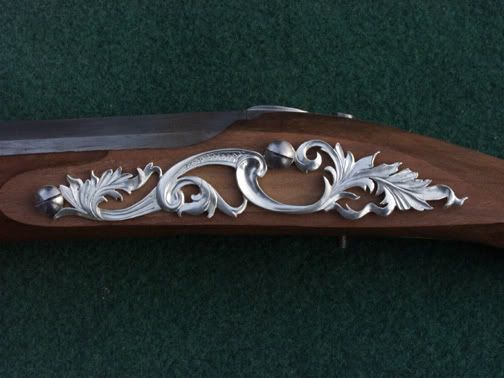Hi,
My Dad had a great woodworking shop in our basement and I tinkered in there under his supervision from a very early age. In the late 1970s, a friend bought a TC Hawken and we all went out and spent some afternoons shooting with it. Dad and I had a lot of fun but both of us thought we could make a better gun if we could get a lock and barrel. We discovered Dixie Gun Works and I bought a barrel, buttplate, trigger guard,a Siler lock kit,a plank of maple,and Richard McCrory's little book on making a longrifle. We built a rifle, with many mistakes, but it looked pretty nice and shot well. My Dad was an excellent wood carver as well as a good all-round wood and metal worker so I learned a lot from him. Mostly, I learned on my own making guns and pistols. Bill Kennedy helped me a lot, particularly showing me his restoration work on originals and guns he made. I learned what long rifles really looked like from him and hanging around Vince Nolt's Eagle museum. Vince kindly let me inspect and handle several originals. Also, at that time (early 1980s), the Washington's Headquarters Historical Museum in Morristown, NJ, near my boyhood home, was much less formal and institutional. They were a very small operation and the curator gave me access to one of their back rooms stuffed with antique guns. Most were donated to the museum and not appropriate for Rev War period, so they sat in the back. Most were Civil War period guns but there were several high-end English sporting guns and early percussion rifles. I learned a lot from that collection. In the mid 1980's, I left NJ to pursue degrees and a career in wildlife ecology. Eventually I wound up in Alaska with a PHD and a job with Alaska Fish and Game studying wolves and deer. I did not build many guns during that time until 2000, when I finally had a permanent shop again. My wife was a gifted graphic designer and woodworking artist. She taught me a great deal about art and design, knowledge which I now use constantly. Gail passed away in 2012, I left Alaska in 2013, and set up shop in Braintree, Vermont by early 2014. I am semi-retired, build mostly for fun, and love a challenge. My Dad taught me how to carve and basic wood and metal working. My wife taught me design and the rest I picked up on my own by doing, including engraving. I have a large library, so I do my homework, make a plan, and then jump in with both feet. Often I sink, but sometimes I swim. I only sunk a little on the rifle above.
dave






